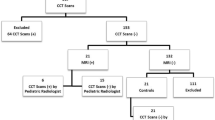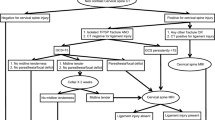Abstract
Pediatric patients with suspected cervical spine injuries (CSI) often receive a computed tomography (CT) scan as an initial diagnostic imaging test. While sensitive, CT of the cervical spine carries significant radiation and risk of lethal malignant transformation later in life. Plain radiographs carry significantly less radiation and could serve as the preferred screening tool, provided they have a high functional sensitivity in detecting pediatric patients with CSI. We hypothesize that plain cervical spine radiographs can reliably detect pediatric patients with CSI and seek to quantify the functional sensitivity of plain radiography as compared to CT. We analyzed data from the NEXUS cervical spine study to assess the sensitivity of plain radiographs in the evaluation of CSI. We identified all pediatric patients who underwent plain radiographic imaging, and all pediatric patients found to have CSI. We then determined the sensitivity of plain radiographs in detecting pediatric patients with CSI. We identified 44 pediatric patients with CSI in the dataset with age ranging from 2 to 18 years old. Thirty-two of the 44 pediatric patients received cervical spine plain films as a part of their workup. Plain films were able to identify all 32 pediatric patients with CSI to yield a sensitivity of 100 % in detecting injury victims (95 % confidence interval 89.1–100.0 %). Plain radiography was highly sensitive for the identification of CSI in our cohort of pediatric patients and is useful as a screening tool in the evaluation of pediatric CSI.

Similar content being viewed by others
References
Daffner RH, Weissman BN, Wippold FJ et al. ACR appropriateness criteria® suspected spine trauma. American College of Radiology. Accessed 21 July 2015
Holmes JF, Akkinepalli R (2005) Computed tomography versus plain radiography to screen for cervical spine injury: a meta-analysis. J Trauma 58(2):902–905
Brenner DJ, Hall EJ (2012) Cancer risks from CT scans: now we have data, what next? Radiology 265(2):330–331
Sinnott B, Ron E, Schneider AB (2010) Exposing the thyroid to radiation: a review of its current extent, risks, and implications. Endocr Rev 31(5):756–773
Chan PN, Antonio GE, Griffith JF, Yu KW, Lipik V, Wong TT (2005) Computed tomography for cervical spine trauma. The impact of MDCT on fracture detection and dose deposition. Emerg Radiol 11(5):286–290
Adelgais KM, Browne L, Holsti M, Metzger RR, Murphy SC, Dudley N (2014) Cervical spine computed tomography utilization in pediatric trauma patients. J Pediatr Surg 49(2):333–337
Mower WR, Hoffman JR, Pollack CV Jr, Zucker MI, Browne BJ, Wolfson AB (2001) Use of plain radiography to screen for cervical spine injuries. Ann Emerg Med 38(1):1–7
Hannon M, Mannix R, Dorney K, Mooney D, Hennelly K (2015) Pediatric cervical spine injury evaluation after blunt trauma: a clinical decision analysis. Ann Emerg Med 65(3):239–247
Nigrovic LE, Rogers AJ, Adelgais KM, et al. (2012) Utility of plain radiographs in detecting traumatic injuries of the cervical spine in children. Pediatr Emerg Care 28(5):426–432
Lutterman AC, Moreno CC, Mittal PK, Kang J, Applegate KE (2014) Cumulative radiation exposure estimates of hospitalized patients from radiological imaging. J Am Coll Radiol 11(2):169–175
Hoffman JR, Mower WR, Wolfson AB, Todd KH, Zucker MI (2000) Validity of a set of clinical criteria to rule out injury to the cervical spine in patients with blunt trauma. National Emergency X-Radiography Utilization Study group. N Engl J Med 343(2):94–99
Hoffman JR, Wolfson A, Todd K, Mower WR (1998) Selective cervical spine radiography in blunt trauma: methodology of the National Emergency X-Radiography Utilization Study (NEXUS). Ann Emerg Med 32:461–469
Woodring JH, Lee C (1992) The role and limitations of computed tomographic scanning in the evaluation of cervical trauma. J Trauma 33(5):698–708
Borock EC, Gabram SG, Jacobs LM, Murphy MA (1991) A prospective analysis of a two-year experience using computed tomography as an adjunct for cervical spine clearance. J Trauma 31(7):1001–1005
Acheson MB, Livingston RR, Richardson ML, Stimac GK (1987) High-resolution CT scanning in the evaluation of cervical spine fractures: comparison with plain film examinations. AJR Am J Roentgenol 148(6):1179–1185
Tat ST, Mejia MJ, Freishtat RJ (2014) Imaging, clearance, and controversies in pediatric cervical spine trauma. Pediatr Emerg Care 30(12):911–915
Greenbaum J, Walters N, Levy PD (2009) An evidenced-based approach to radiographic assessment of cervical spine injuries in the emergency department. J Emerg Med 36(1):64–71
Patel JC, Tepas JJ 3rd, Mollitt DL, Pieper P (2001) Pediatric cervical spine injuries: defining the disease. J Pediatr Surg 36(2):373–376
Jaffe DM, Binns H, Radkowski MA, Barthel MJ, Engelhard HH 3rd (1987) Developing a clinical algorithm for early management of cervical spine injury in child trauma victims. Ann Emerg Med 16(3):270–276
Schneider AB, Ron E, Lubin J, et al. (1993) Dose-response relationships for radiation-induced thyroid cancer and thyroid nodules: evidence for the prolonged effects of radiation on the thyroid. J Clin Endocrinol Metab 77:362–369
Brenner DJ, Elliston CD, Hall EJ, Berdon WE (2001) Estimated risks of radiation-induced fatal cancer from pediatric CT. AJR Am J Roentgenol 176(2):289–296
National Cancer Institute (2012) Radiation risks and pediatric computed tomography. National Cancer Institute. National Institutes of Health. Web. 21 Jan 2015
Author information
Authors and Affiliations
Corresponding author
Ethics declarations
Conflict of interest
The authors declare that they have no conflict of interest.
Additional information
Author contributions
LWC, MAP, WRM, and JRH participated in the project development, data analysis, manuscript composition, and critical review. WRM and JRH participated in data collection.
Appendix
Appendix
The following centers and investigators collaborated in the NEXUS study: principal investigator—W. Mower; co-investigator—J. Hoffman; steering committee—J. Hoffman, W. Mower, K. Todd, A. Wolfson, and M. Zucker; site investigators—Antelope Valley Medical Center (Los Angeles): M. Brown and R. Sisson; Bellevue Hospital (New York): W. Goldberg and R. Siegmann; Cedars–Sinai Medical Center (Los Angeles): J. Geiderman and B. Pressman; Crawford Long Hospital (Atlanta): S. Pitts and W. Davis; Egleston Children’s Hospital (Atlanta): H. Simon and T. Ball; Emory University Medical Center (Atlanta): D. Lowery and S. Tigges; Grady Hospital (Atlanta): C. Finney and S. Tigges; Hennepin County Medical Center (Minneapolis): B. Mahoney and J. Hollerman; Jacobi Medical Center (Bronx, N.Y.): M. Touger, P. Gennis, and N. Nathanson; Maricopa Medical Center (Phoenix, Ariz.): C. Pollack and M. Connell; Mercy Hospital of Pittsburgh (Pittsburgh): M. Turturro and B. Carlin; Midway Hospital (Los Angeles): D. Kalmanson and G. Berman; Ohio State University Medical Center (Columbus): D. Martin and C. Mueller; Southern Regional Hospital (Decatur, Ga.): W. Watkins and E. Hadley; State University of New York at Stony Brook (Stony Brook): P. Viccellio and S. Fuchs; University of California, Davis, Medical Center (Sacramento): E. Panacek and J. Holmes; University of California, Los Angeles, Center for the Health Sciences (Los Angeles); J. Hoffman and M. Zucker; University of California, San Francisco, Fresno University Medical Center (Fresno, Calif.): G. Hendey and R. Lesperance; University of Maryland Medical Center (Baltimore): B. Browne and S. Mirvis; University of Pittsburgh Medical Center (Pittsburgh): A. Wolfson and J. Towers; Hermann Hospital, University of Texas Health Sciences Center (Houston): N. Adame, Jr., and J. Harris, Jr.
Rights and permissions
About this article
Cite this article
Cui, L.W., Probst, M.A., Hoffman, J.R. et al. Sensitivity of plain radiography for pediatric cervical spine injury. Emerg Radiol 23, 443–448 (2016). https://doi.org/10.1007/s10140-016-1417-y
Received:
Accepted:
Published:
Issue Date:
DOI: https://doi.org/10.1007/s10140-016-1417-y




